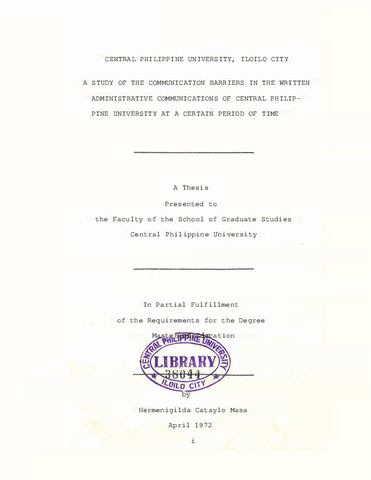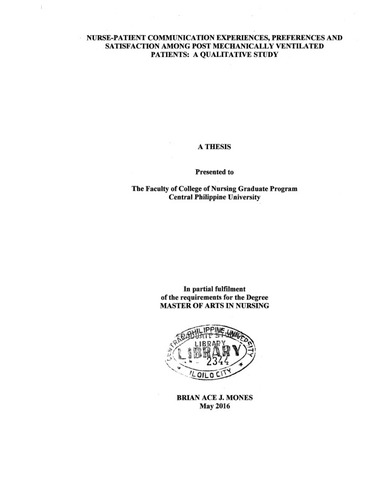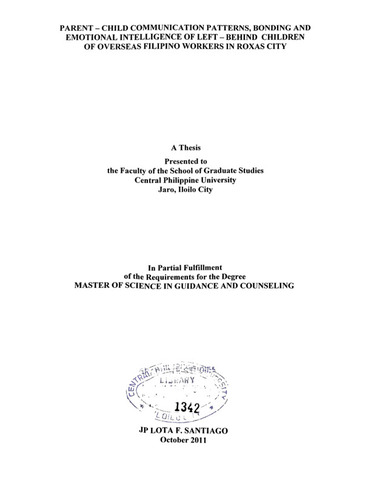A study of the communication barriers in the written administrative communications of Central Philippine University at a certain period of time
| dc.contributor.adviser | Ruiz, Macario B. | |
| dc.contributor.adviser | Griño, Eliza U. | |
| dc.contributor.author | Masa, Hermenigilda C. | |
| dc.date.accessioned | 2021-06-09T06:30:55Z | |
| dc.date.available | 2021-06-09T06:30:55Z | |
| dc.date.issued | 1972 | |
| dc.identifier.citation | Masa, H. C. (1972). A study of the communication barriers in the written administrative communications of Central Philippine University at a certain period of time (Unpublished Master's thesis). Central Philippine University, Jaro, Iloilo City. | en_US |
| dc.identifier.uri | https://hdl.handle.net/20.500.12852/998 | |
| dc.description | Abstract only | en_US |
| dc.description.abstract | The Problem. The basis for this study was 1,052 written administrative communications gathered from twenty two academic offices of the university from July, 1970 to April, 1971. Specifically, this study sought answers to the following questions: (1) To what extent do administrative communication barriers exist in Central Philippine University? (2) What types of communication barriers are they? (5) In what parts of the communication process are these barriers likely to be found? (4) What specific types of barriers are the most common in the university? (5) In what period of the year do they mostly occur? (6) What office has the most barriers per unsuccessful communication? (7) How serious are these barriers? The Procedure. The investigator collected her data by waves. The facts gathered from interviews with receivers of the communications enabled the investigator to identify the communication barriers. These barriers were classified into types. The significance of the difference between the communication failures of types of offices was determined with the use of the t-ratio. Offices which were found to have unsuccessful communications were categorized according to the degree of their lack of success. Occurrences of barriers under each part of the communication process were recorded in order to find out where most of the blockages occurred. The chi-square was used to test the tendency of parts of the communication process to be barrier-ridden. Frequency of occurrence of specific types of barriers was noted in order to determine what barriers were common. The barrier-ridden month was determined by the total number of incidence of all the types of communication barriers noted per month; and a barrier-ridden office was identified by the average number of barriers present per one unsuccessful written communication sent by it. To determine the seriousness of communication barriers, occurrences which resulted in any of the three types of specified difficulties were noted and reduced into percentages of the total number of barriers. The Findings and Conclusions. The college offices xiii were more unsuccessful than the department offices. The volume of written communications had no relationship to the degree of unsuccessfulness in written communication. The degree of lack of success in written communications at Central Philippine University being only 20 per cent of the total number of communications gathered, it can be considered slight. Human barriers predominated in unsuccessful communications. Of these, individual differences caused the most difficulty. The communication blocks occurred most heavily in the Receiver part of the communication process. Common barriers found in the university were of many types. The months of March, October, and February were the most barrier-ridden months. These were the months for special occasions and much co-curricular activity. The most barrier-ridden office had an average of 3 2/5 communication barriers per unsuccessful written communication. A barrier-ridden office tended to be one with a head who held other offices and with a large percentage of part-time employees in its staff. Only about six per cent of all the communication barriers were found to be serious; it can therefore be said that the system as a whole was functioning efficiently. The Recommendations. On the basis of the findings, the following recommendations are offered: (1) that the university hold a seminar on how to improve its communication set up; (2) that the university administration restudy the teaching and working loads of employees; (3) that the university study the possibility of redistributing some of the extra-curricular activities; (4) that the consequences of serious written communication barriers be studied, so that guilty parties could be dealt with accordingly; (5) that the university continue to hold once a year an orientation program or seminar where the faculty members and employees are oriented about objectives, organizational set up, activities, privileges, and opportunities; (6) that the administration delegate administrative functions and academic functions to more than one office. This study suggests the following researches to be undertaken: (1) A study of the human barriers in the administrative communication system in Central Philippine University in order to discover means of eliminating or minimizing them. (2) A further study of the effects of such apparently adverse factors as heavy teaching loads and extra-curricular activities, and the employment of part-time teachers; and of the time involved in the initiation, transmission, and reception of communications in Central Philippine University. (3) A case study of serious communication barriers and their effects on the communication system. | en_US |
| dc.format.extent | xiv, 138 leaves | en_US |
| dc.language.iso | en | en_US |
| dc.rights | Attribution-NonCommercial-NoDerivs 3.0 Philippines | * |
| dc.rights.uri | http://creativecommons.org/licenses/by-nc-nd/3.0/ph/ | * |
| dc.subject.ddc | GSL Theses 378.242 M37 | en_US |
| dc.subject.lcsh | Communication | en_US |
| dc.subject.lcsh | Written communication | en_US |
| dc.subject.lcsh | Central Philippine University | en_US |
| dc.subject.lcsh | Universities and colleges--Administration | en_US |
| dc.subject.lcsh | Central Philippine University--Administration | en_US |
| dc.subject.lcsh | Written communication--Evaluation | en_US |
| dc.title | A study of the communication barriers in the written administrative communications of Central Philippine University at a certain period of time | en_US |
| dc.type | Thesis | en_US |
| dc.description.bibliographicalreferences | Includes bibliographical references | en_US |
| dc.contributor.chair | Herradura, Elma S. | |
| dc.contributor.committeemember | Espada, Wilfredo G. | |
| dc.contributor.committeemember | Ruiz, Macario B. | |
| dc.contributor.committeemember | Griño, Eliza U. | |
| dc.contributor.department | School of Graduate Studies | en_US |
| dc.description.degree | Master of Education | en_US |
| local.relation.associatedcontent | https://repository.cpu.edu.ph/handle/20.500.12852/2076 Journal article published in Southeast Asia Journal | en |






